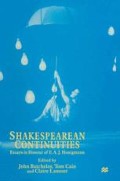Abstract
In 1903 David Nichol Smith published a collection of eighteenth-century essays on Shakespeare in order to demonstrate that ‘there are grounds for reconsidering the common opinion that the century did not give him his due’, and that ‘the eighteenth century knew many things which the nineteenth century has rediscovered for itself’.2 The problem was that Romantic Shakespeare criticism had obscured or had appeared thoroughly to trump that of the previous era. In recent years, a great deal of expert attention has been productively paid to reassessing the state of Shakespeare and Shakespeare studies in the period 1750 to 1830. For example, Jonathan Bate has written on eighteenth-century and Romantic appropriations of Shakespeare in poetry and popular culture,3 and at least four books have been published in the last seven years on editing Shakespeare in the eighteenth century.4 This is aside from the more general surveys of Bardolatry, of Shakespeare’s many lives, and more theoretical considerations of the meanings of Shakespeare.
To the honour of a profession long held in contempt by the wise — and still contemned by the weak — Shakespeare, the pride of Britain, was a player. For the comfort of the illiterate, he was unlearned; and, to the shame of the vain and petulant author, he was weak and humble.
Elizabeth Inchbald1
Access this chapter
Tax calculation will be finalised at checkout
Purchases are for personal use only
Preview
Unable to display preview. Download preview PDF.
Notes
David Nichol Smith (ed.), Eighteenth-Century Essays on Shakespeare (Oxford: Clarendon Press, 1903, 2nd edn 1963), Preface to first edition, p. iii.
Jonathan Bate, Shakespeare and the English Romantic Imagination (Oxford: Clarendon Press, 1986)
Simon Jarvis, Scholars and Gentlemen: Shakespearean Textual Criticism and Representations of Scholarly Labour 1725–1765 (Oxford: Clarendon Press, 1995)
Peter Martin, Edmond Mahne: Shakespearean Scholar: A Literary Biography (Cambridge: Cambridge University Press, 1995)
Peter Seary, Lewis Theobald and the Editing of Shakespeare (Oxford: Clarendon Press, 1990)
Fred Parker, Johnson’s Shakespeare (Oxford: Clarendon Press, 1989).
Brian Vickers’ six-volume anthology, Shakespeare: The Critical Heritage, 1623–1801 (London: Routledge and Kegan Paul, 1974–81)
See, for example, Jane Aaron, A Double Singleness: Gender and the Writings of Charles and Mary Lamb (Oxford: Clarendon Press, 1991)
Peter Erickson (ed.), Rewriting Shakespeare, Rewriting Ourselves (Berkeley: University of California Press, 1991)
Marlon B. Ross, The Contours of Masculine Desire: Romanticism and the Rise of Women’s Poetry (New York: Oxford University Press, 1989).
Ellen Donkin, Getting into the Act: Women Playwrights in London 1776–1829 (London: Routledge, 1995)
Mary Anne Schofield and Cecilia Macheski (eds), Curtain Calls: British and American Women and the Theater, 1660–1820 (Athens: Ohio University Press, 1991)
Margaret Anne Doody, ‘Shakespeare’s Novels: Charlotte Lennox Illustrated’, Studies in the Novel 19 (1987), 296–310.
See Emmett L. Avery, ‘The Shakespeare Ladies Club’, Shakespeare Quarterly 7 (1956), 153–8
Jane Austen, Mansfield Park, ed. James Kinsley and John Lucas (Oxford: World’s Classics, 1980), p. 306.
Voltaire’s many writings on Shakespeare were gathered into one volume by Theodore Besterman, published in the series Studies on Voltaire and the Eighteenth Century, vol. 54 (1967)
Besterman, Voltaire (Chicago: Chicago University Press, 1969, 1976), pp. 131–58.
For example, she omits Widow Capilet, Diana and Mariana (All’s Well); and Froth, Mistress Overdone, Pompey and Mariana (Measure for Measure). For the argument that Shakespeare’s comedies provide a liberating middle space, see Carol Neely, Broken Nuptials in Shakespeare’s Plays (New Haven: Yale University Press, 1985).
Anna Jameson, Shakespeare’s Heroine’s: Characteristics of Women, Moral, Poetical, and Historical (London: G. Bell and Sons, 1911), p. 31.
Editor information
Copyright information
© 1997 Palgrave Macmillan, a division of Macmillan Publishers Limited
About this chapter
Cite this chapter
Hawley, J. (1997). Shakespearean Sensibilities: Women Writers Reading Shakespeare, 1753–1808. In: Batchelor, J., Cain, T., Lamont, C. (eds) Shakespearean Continuities. Palgrave Macmillan, London. https://doi.org/10.1007/978-1-349-26003-4_20
Download citation
DOI: https://doi.org/10.1007/978-1-349-26003-4_20
Publisher Name: Palgrave Macmillan, London
Print ISBN: 978-1-349-26005-8
Online ISBN: 978-1-349-26003-4
eBook Packages: Palgrave Literature & Performing Arts CollectionLiterature, Cultural and Media Studies (R0)

